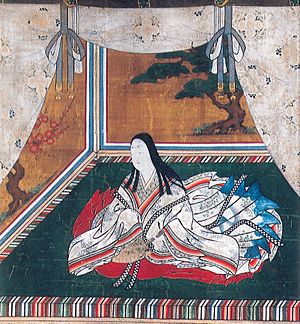Empress Genshō facts for kids
Quick facts for kids Empress Genshō元正天皇 |
|||||
|---|---|---|---|---|---|

Portrait of Empress Genshō (Edo Period)
|
|||||
| Empress of Japan | |||||
| Reign | October 3, 715 – March 3, 724 | ||||
| Predecessor | Genmei | ||||
| Successor | Shōmu | ||||
| Born | Hidaka (氷高 or 日高) 682 Asuka, Japan |
||||
| Died | May 22, 748 (aged 65–66) Nara, Japan |
||||
| Burial | Nahoyama no nishi no misasagi (奈保山西陵) (Nara) | ||||
|
|||||
| House | Yamato | ||||
| Father | Prince Kusakabe | ||||
| Mother | Empress Genmei | ||||
Empress Genshō (元正天皇, Genshō-tennō, 682 – May 22, 748) was the 44th ruler of Japan. She was an empress who reigned from 715 to 724.
Genshō was one of only eight women who ruled Japan as empresses. What made her special was that she was the only empress to take over from another empress, her mother, Empress Genmei. Most empresses before and after her inherited the throne from a male ruler.
Contents
Becoming Empress of Japan
Before she became empress, her personal name was Hidaka-hime. She was the older sister of Emperor Monmu. Her parents were Prince Kusakabe and Empress Genmei. This means she was the granddaughter of both Emperor Tenmu and Empress Jitō through her father. She was also the granddaughter of Emperor Tenji through her mother.
Why Genshō Became Empress
Empress Genshō became ruler to hold the throne for her nephew, Prince Obito. He was the son of her younger brother, Emperor Monmu, who had passed away. Prince Obito was still too young to rule. He would later become Emperor Shōmu.
In 714, Prince Obito was named the Crown Prince, meaning he was next in line for the throne. The next year, in 715, Empress Genmei, who was in her fifties, decided to step down. She gave the throne to her daughter, Genshō. At this time, Prince Obito was 14 years old.
- 715: Empress Genmei stepped down from the throne. Her daughter, Princess Hidaka, became Empress Genshō. She ruled as a temporary empress for her nephew.
Prince Obito remained the Crown Prince, ready to take over when he was older. Fujiwara no Fuhito, a very powerful person in the court, stayed in his important job until he died in 720. After Fuhito's death, Prince Nagaya, who was Empress Genshō's cousin, gained a lot of power. This change led to some disagreements later on between Nagaya and Fuhito's four sons.
Important Events During Her Reign
During Empress Genshō's time as ruler, several important things happened:
- The Nihon Shoki was finished: In 720, the Nihon Shoki was completed. This was the very first official history book of Japan. It tells the story of Japan from ancient times.
- Laws were updated: The government continued to work on a system of laws called ritsuryō. These laws helped organize the country. Fujiwara no Fuhito started this work, and after he died, his grandson, Fujiwara no Nakamaro, helped finish them. These laws were published as the Yōrō ritsuryō.
- New land rules: The way taxes were collected was not working well. To get more money for the government, a new law was made in 723. This law, called the "Act of possession in three generations," allowed people to own new farmland they created for three generations. After that, the land would go back to the government. This was meant to encourage people to grow more food, but it only lasted for about 20 years.
Empress Genshō ruled for nine years. Even though there were other empresses, most of them were followed by a male ruler from the royal family. Empress Genshō and her mother, Empress Genmei, are special because Genshō took the throne directly from her mother.
Later Life and Legacy
In 724, Empress Genshō stepped down from the throne. She gave the power to her nephew, Prince Obito, who became Emperor Shōmu.
Genshō lived for 25 years after she stopped being empress. She never got married and did not have any children. She passed away when she was 65 years old.
Her grave is in Nara, Japan. There is also a special Shinto shrine where she is honored. The place is called Nahoyama no nishi no misasagi. You can visit her tomb today in Narazaka-chō, Nara City.
Eras of Genshō's Reign
In Japan, years are often grouped into special periods called nengō. Here are the eras during Empress Genshō's rule:
Family Tree
Empress Genshō, whose birth name was Princess Hidaka, was the oldest child of Empress Genmei and Prince Kusakabe. She had one younger brother, Emperor Monmu, and one younger sister.
Empress Genshō never married or had children. The throne was passed to her nephew, Emperor Shōmu, who was her younger brother's son.
See also
 In Spanish: Genshō Tennō para niños
In Spanish: Genshō Tennō para niños

